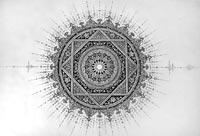
Traditional Iranian art risks fading into historyTEHRAN, (AFP) - Bent over his desk, an Iranian illuminator puts the last touches on a gilded garden of the minuscule intertwined paisleys that have decorated the Koran for hundreds of years.
One of the oldest Iranian art forms, illumination (tazhib) has survived since the pre-Islamic era but now risks extinction if it fails to attract patrons, who prefer modern art to traditional work.
"The perfection and harmony of this art speaks for itself," said illuminator Fereidoon Joghan, who has spent the past quarter of a century mastering this most rarefied of arts. "I would like to create something beautiful rather than screaming a message," said the artist, who has won numerous national awards in Islamic decorative arts. Joghan tries to work using traditional methods, including brushes made from cat's fur, and remaining as faithful as possible to the motifs and techniques created by masters hundreds of years ago. Ridiculed by peers in Tehran's prestigious school of fine arts for his passion, Joghan said he had to abandon illumination temporarily at college, where he experimented with modern painting."The harmony and the intense concentration calms me to an extent that I forget all my problems," he said. The art dates back to the Sassanid era in pre-Islamic Iran but flourished after the seventh-century advent of Islam, which banned human depictions. Faced with such limitations, Iranian artists poured their creative talent into beautifying the holy script, carpets and mosques."After Islam, the Koran was the only outlet of artistic work and it was the sanctity and importance of the book that has kept illumination alive through the ups and down of history," said fellow tazhib artist Mehdi Moghiseh. The best works of illumination were created in the 15th century under the Timurid dynasty, when Iran's rulers of Mongol origin were great patrons of Persian art and literature.
This heyday of tazhib was sponsored by rulers who commissioned artists to enhance calligraphy in Koran and complement miniatures in the "Shahnameh" (Book of Kings), a 10th-century poetic chronicle of Iran's myths and ancient history. Both artists are pessimistic about the future of tazhib, however, as it is almost impossible to market the work in the modern world. Joghan spends eight hours a day working for four months on a piece no larger than a medium-sized book which is worth 100 million rials (11,000 dollars). He has not sold a work in years. The related, figurative, art of miniature painting stands a better chance of survival, experts say, although at a recent exhibition not a single piece could convince visitors to part with their money."If the masters cannot make a living out of their work it will fade away. They have to be protected like an endangered species. This is our heritage, our identity," Moghiseh said. He believes people's lack of interest partly stems from the absence of traditional art forms in modern surroundings. Moreover, Iran's younger generation also favours art forms which yield immediate results and allow a more liberated expression. Visiting Tehran's Reza Abbasi museum, which preserves masterpieces of Iranian miniature, ceramic, calligraphy and illumination, 29-year-old Kamran Hamzeloo is unimpressed by the artistic achievements of his ancestors. "The works are lovable and subtle, but I think if the Iranian artist of the time had more freedom he would have looked at the world differently," he said, looking at a 15th century miniature created by the artist after whom the museum is named. |
|| Front
Page | News | Editorial | Columns | Sports | Plus | Financial
Times | International | Mirror | TV
Times | Funday
Times || |
| |
Copyright
2007 Wijeya
Newspapers Ltd.Colombo. Sri Lanka. |

